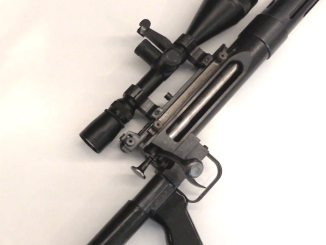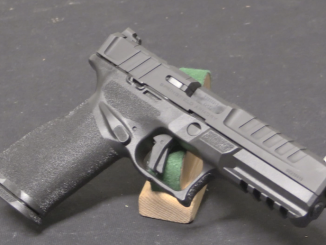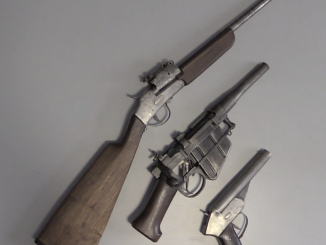The Šokac is just one of more than a dozen different submachine guns developed and produced domestically in Croatia during the Yugoslavian civil war of the early 1990s. It is a mechanical copy of the Soviet PPSh-41 made in 9x19mm and a folding stock modeled after the vz25 family of submachine guns. Like the PPSh, it has a selector for semiauto or fully automatic fire, and used stick magazines of 25- and 30-round capacity. The Šokac was first tested in August of 1991, and it appears that as many as 5,000 were produced in total.
Today we are looking at both an early metal-framed example with a wooden grip and a later (and more typical) type with a plastic grip and magazine housing. There were also at least a few made with underfolding MP40-type stocks.
Thanks to Kessler Auktionen AG for letting me film some of their guns. If you are looking for interesting and unusual arms in Europe, make sure to check them out!




Don’t remember having seen this one “back then”, mostly Zastava-made AKs, one Ppsh43, and a couple stocked broomhandle pistols.
But we rarely moved into Croatia itself.
Maybe one answer (and also COULD explain the smallish pistol grip) could be that these were spread as home protection for use by women and the very young while the men were “at the front”?
Interesting design, nonetheless.
Let’s see how that explanation works: high fire rate, small grip, and a reasonably powerful cartridge for the purpose. Easy to use, and not likely to be used for anything beyond one’s house. Perhaps one could also hide this in the family car, should the mother be stopped with ill intent on part of the person doing the stopping after a grocery run. And I don’t want to imagine the fate of any child molester when Mom’s right behind him. I could be wrong…
“Ppsh43”
Wait. Please choose exactly one
PPSh – Shpagin sub-machine gun, alias PPSh-41
PPS – Sudayev sub-machine gun, alias PPS-43
Sorry, slipped an extra “H”.
A PPS-43, carried by a “police agent”, close to Stolac, I think (before the crossroad with a knocked-out T34 and a grafitti with the face of Saddam Hussein).
Jose
Very interesting and imaginative description of why so small of a pistol grip , but of course not true.
In guns of similar fashion and time frame of makeshift production it is hard to explain all the elements and why were they chosen – possibly it was out of inexperience; when somebody in production on higher level became aware of smallish grips, maybe it was too late and too costly to bother with making of the new molds for plastic injection.
Many of these people were very skilled in industrial production, but had zero firearms experience or knowledge.
To have a guy of Ian’s scope of knowledge on their disposal at the time would be invaluable, as person like him has examined a hundreds or thousands of firearms and has direct experience how something works, and what works the best in practice.
For example, better question would be why the spring and buffer carrier has not been moved further to the back – there is clearly unused space, thus you would have at least a possibility of slightly lower RPM.
If this was a professional firearms factory with design and research departments (that took years to perfect!) I suppose they would alleviate these shortcomings, but here, again, did not bother too much,
as it was like 5000, not 500 000 of them to be made.
Another question is why it was 10-20 different designs, wouldn’t it be better to produce, like in Britain was, only a STEN by many small cottage workshops who all produce a single simple part, or even only 1 operation (for example with Sten, one small shop turned bolt on the lathes, and shipped them with a truck to another village where they, in former chicken pen or similar place, had a milling machine and housewives did milling operations !? talk about ludicrous dispersed production).
But again, think of the different situation for example you have a warzone near one town (in Britain it never was),
its factories make only a receiver and springs, and you need a magazines that are made 500km away, bolts that are made 200km away, and most of the roads to town were cutoff – basicly you cannot finish a single gun to working condition.
So, maybe with these conditions, it is better that one small workshop makes everything on smaller scale, with various designs, that can immediately be put to use. And that’s whats happened here.
From purely researchers standpoint, a shame that similar thing did not happened in GB also; we would now not examine only 4-5 versions of STEN (of which 2 were made in most numbers),
but 20-30 indigenous made mostly different smg models.
Not the craziest explanation I can think. That’s why I begin with “Maybe” 😉
Unless we locate the designer and ask him, we can only speculate about all the design decisions you mention.
About capabilities, there were quite a few barely used state-owned factories (many of them abandoned early on), some in the middle of nowhere, built by Tito to reduce unemployment (even if economically made no sense).
At least that was the explanation we were given when the one lane mountain road became a four-lane for a couple kilometers and we stumbled upon a factory in the middle of the mountains. Originally, people from small towns several kilometers around it worked there, but most of those villages were abandoned by 96.
You remember the name of that place maybe ?
Most famous of all these flawed economically-ideological projects was one infamous alumina factory, it was close to the frontlines (near Obrovac),
so maybe you are referring to that place,
unless you speak about something from Bosnia and Herzegovina.
There are many studies why that factory failed, one unofficial suggested that 1973 price change in oil (which skyrocketed) was maybe by far the greatest factor.
Also after that time (70s) Yugoslavian industrial “miracle” started to decline.
Sorry for delay answering.
One of the factories we visited could have been Obrovac (the name sounds familiar).
But I cannot be sure since, back then, I wasn’t paying that much attention to some things, more worried about doing my job (and not stepping onto a mine) than the name of the place they took me that day.
Nowadays, I would behave differently. The sad part about experience is that you don’t have it when you need it the most.
If its mountainous region, it could be near Gospić,
“MOL” factory in Lički Osik, metal machining factory,
but it was under control of the local Serbs rebels (SAO Krajina) during the war (and probably also before the war, as there were lot of serb villages around it with people working in it).
There were stories that this factory produced mortar shells (or some parts for it) before the war (in 1950-60s or so),
but during the war I don’t think it made anything directly military related, or even made anything at all (serb rebels unemployment rate was like 90% or higher – practically all available men were drafted in their army).
After the war it was supposedly found intact and in few months dismantled and machines stolen and sold away God knows where.
***double stack/single feed***
afaik these guns were produced at the railroad workshops in slavonski brod during and after the battle of vukovar, thus the name (šokaz = person from slavonia, a region in east croatia).
most guns were destroyed after the war, when the newly formed croatian govt offered a substantial reward for handing in select-fire weapons etc
Reason for so much similarity is that whatever workshop made it it probably used stored machinery that was supposed to be used in case of war for maintenance of existing weapons, in this particular case PPSh.
Every republic in SFRY had Territorial defense which was armed with older weapons (there were exceptions, Slovenian one was quite well equipped), and to maintain all those mish-mash of the weapons during the war there was stored machinery and factory/depot drawings for their maintenance.
That is a reason why MP-40, PPSh, Sten and Beretta inspired SMGs were made – part of the machinery and a good set of factory drawings existed for those.
With Đuro Đaković factory (where Šokac was made) this blueprints story may even possibly be true to some degree
– there are some Thompson receivers made to mate them with parts they had from these Territorial defense old replacement part stocks.
But in other small workshops that had an idea of “hey lets make a gun for our boys”, that was certainly not the case.
Their best bet was if someone could provide them with Sten or MP40 (maybe from the museum or private collection hidden back from ww2 ?)
that they, more or less successfully, reverse engineered to make some new amalgamated design (9mm caliber+ PPSHbolt+ VZ folding stock+hungarian ak grip etc ; you get the picture how this goes).
In some cases these guns were borrowed from users temporarily, and were not a property of a workshop that could do whatever it wants to them in successfull engineering examination (for example cut them up to test the steel compositions)
The idea of Territorial defense was of having already made guns (rifles from C.Zastava etc. not everything was ww2 old)
stored somewhere that factory workers could easily and quickly use,
in event of some kind of immediate crushing invasion (by USSR or West) against Yugoslavia in some kind of a half megalomaniac “all available people” partisan style insurgency mixed with Volksturm, amped to the max.
And as far as I know they did not evolve that far to the situation where every factory had their readily made plans of what parts to make in case of war – it was still a dictatorship that must be defended both from outside but also an INSIDE enemy,
and as a federation of states there was always an concern that some may try to “break away” from the loving embrace of others that basically more or less governed upon them.
That was the reason why there were no firearms and munitions plants whatsoever in Croatia and Slovenia although they were very industry rich and developed.
(only thing: tanks were “made”- assembled from thousands of parts made in all parts of Yugoslavia in, ĐĐ plant).
One thing Croatia “inherited” was not a direct plant “tanks rolling out like cars” production since some of its (often vital) parts were dispersed on other states that it lost access to,
but the complete technical package for the production, a number of documents that would fill up a few big rigs.
How the history is basically circular with the Balkans, in some crazy scenario in xx number of years that everybody hope will never happen, but secretly know it could,
I wouldn’t be surprised if in that fiction of future some decide to pull out these makeshift “crude copies”, the remaining ones that were not confiscated or destroyed, from museums , to make some new designs upon them,
just like it was done out of necessity with ww2 designs almost 30 years ago.
Sten stayed in TO inventory in the 1985 arms listing, as did MP-40s. Later ones were actually noted in the pictures during the wars (through I think it was in Bosnia about late 1992). Berettas were not in it, but were in 1975, and police in bum-fuck-villes had them until at least 1980.
A lot of factories that had metalworking shops were supposed to have role in the “war production”, or at least reparations of the older weapons, I have found a partial list for Serbia (Belgrade and neighbourhood, it lists even large state owned car mechanic shops), together with what they could do.
There is a lot of unresearched stuff,
in Serbia there hasn’t been so much (if any?) crude development with all those sub machineguns as in Croatia,
but I suppose there are many stories of some firearms development that are not known to the wide public.
Also, I don’t know of any domestic designs (aside some makeshift weaponized vehicles) from so called Krajina and Republic of Srpska made during the war.
There popped up suddenly quite a few of these ‘spanking new firearms shops’ in time of events leading to Croatian separation from Yugoslavia. New government had apparently hands full to regulate them later. One such shop which turned into government sanctioned one and now even acclaimed producer is Hrvatski Samokres (meaning Croatian pistol) or in short HS.
http://www.hs-produkt.hr/en/
HS are producing pistols for Springfield, which retails them in U.S. under their name.
Are the barrels rifled?
Yes.
It was not a civil war, just like the war in Chechnya in the 90s was not a civil war,
I know and its understandable you are not very informed on the subject and history of the “Balkans” since its a small region with very rich historical microcosm that needs a considerable time and effort to study, and did not say it deliberately because its a wide misconception (and one planted on the internet and publications not by mistake).
But overall one does need to be careful with statements in that manner, because in ears of the Croatian people it could sound a bit offending, almost as like somebody would “explain” to the New Yorker who lost a member of the family in 9/11 that it was actually “an inside job”, etc.
This was (still is?) a propaganda to muddle the waters on the international publicity and political issues of the blatant aggression, and it worked by some degree, since west European countries did nothing to prevent it, or stop it after it erupted, and they could easily do that, just like some of them participated in the Desert Storm, but the countries involved are, of course, not abundant in petroleum, so go figure.
By wikipedia knowledge, its officially called Croatian War of Independence, part of the Yugoslav wars.
What really was a civil war, but is almost never called like it, again probably for political reasons, was war on the territory of former Kingdom of Yugoslavia during ww2, where every separate nation and its members were involved and split along serving with axis or allies side and fought inbetween, some of them switching sides occasionally.
Up to a couple of years ago croatian smgs with the old style german neutrilization were selling as low as 250 euroes and post war polish pps 43s were only 66 euroes
Some say that after the war in Croatia you could buy many of these guns, various models (on “unofficial market” of course) for next to nothing,
and many “collectors” today regret that they did not make a collection, probably thinking back in the day that it won’t hold a great value in the future.
But there is a limited number of these guns made, not like PPSh and Stens made in millions, and they will get very rare with time, I strongly suppose.
And they really have a background story to tell.
I don’t have official info, only some assumptions in that many, or even all of them that were in official army stocks, were destroyed after the war, officials probably fearing that they would “seep out” of the depots, to be sold to the general population, or to criminal elements, how it happened with some of them.
Well said Storm.